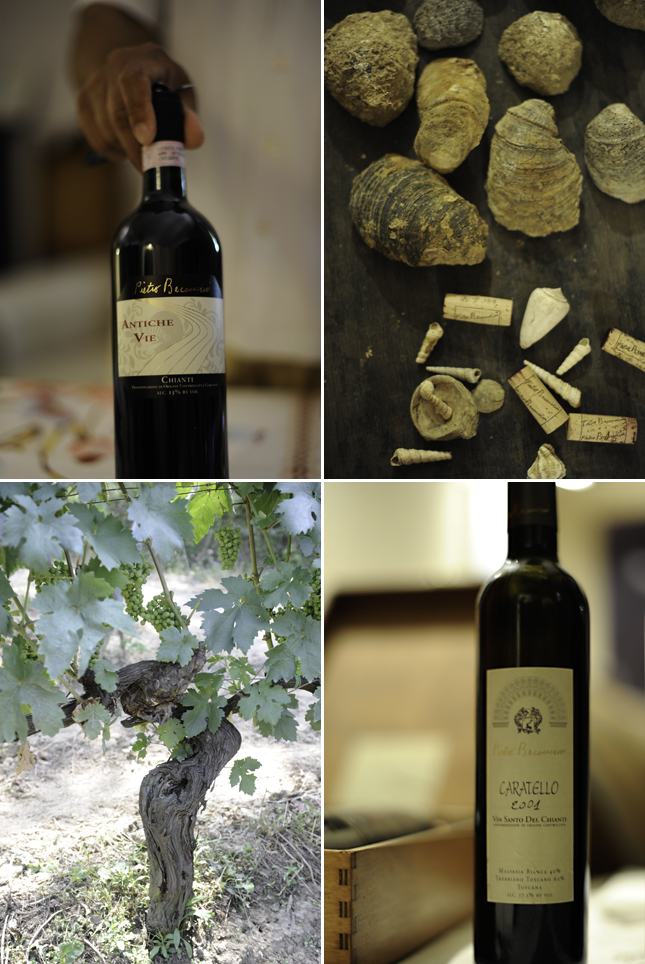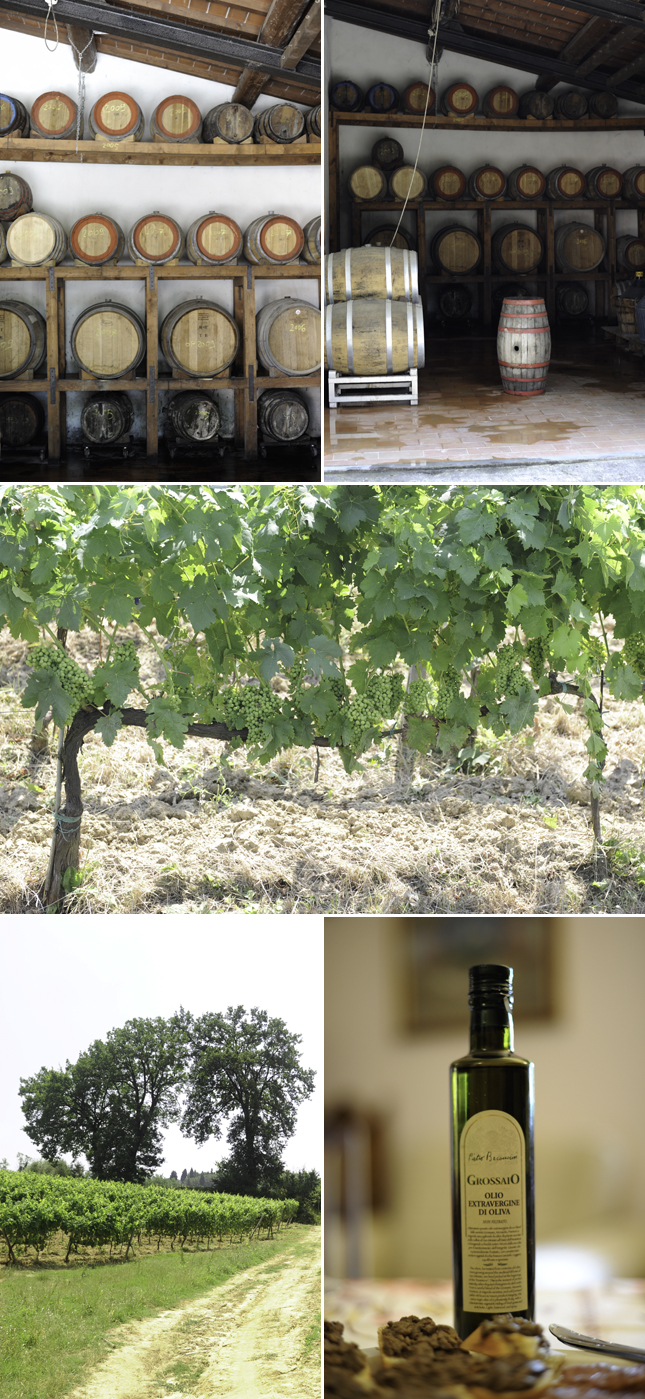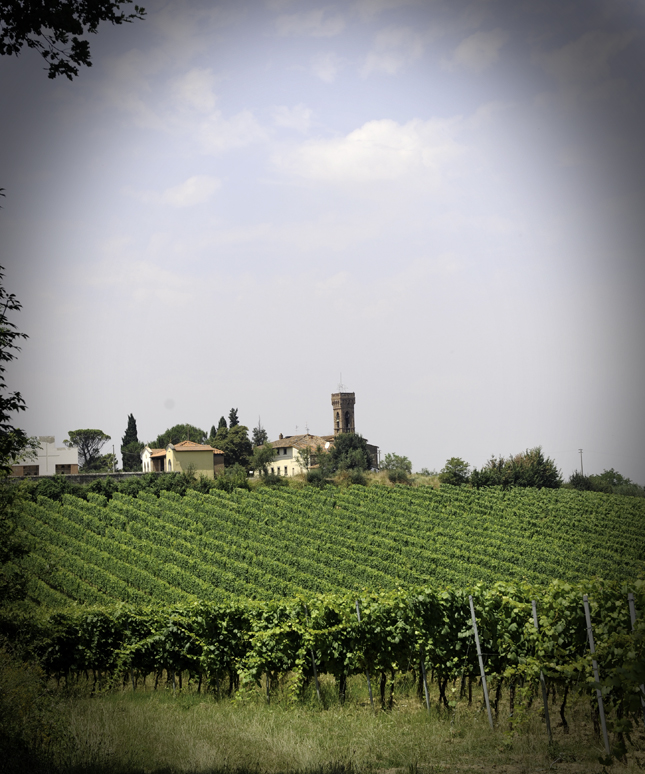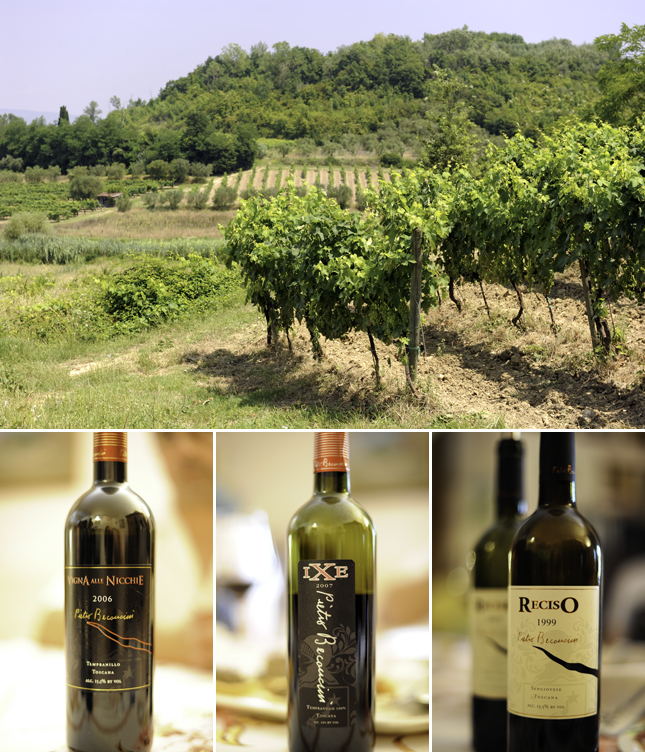San Minato Terroir

If you were blindfolded and placed unknowingly in the vineyards of the Pietro Beconcini estate your first thought might be that you were on a walking beach. Removing the blindfold you would discover that you were standing, quite literally, on sea shells. This is stunning because you would actually be about 45 miles / 70 kilometers from the coast of the Mediterranean Sea, in the hills outside of the town of San Minato, Italy. Looking at the soil under your feet you would think the sea had receded only a week earlier.
The sea withdrew from the region anywhere from 5.3 to 3.6 million years ago in the Pliocene epoch leaving behind the remains of mollusks and other bony fish. Most common in the soil are the shells of limpets, Spondylus, a bivalve the size of a catcher’s mitt and antecedent of today’s oyster and tens of millions of Turritellatricarinata, or corkscrew shaped creatures that judging by their numbers must have created a studded blanket on the sea bed for miles. These shells and the layer of calcari form a millions of year’s old top-soil that, according to Eva Bellagamba, Managing Director and her winemaker husband, “give our wines great personality.”
Moving forward through time to the Medieval era we could stand in the same vineyard without a blindfold and watch as pilgrims passed en route to Santiago di Compostela, Spain. These pilgrims followed the trail that still runs through the vineyard called the Via Francigena. This path connects the Spanish holy city in Galicia with Rome. Along this part of the road the pelligrino (pilgrims) trod unknowingly over the same shells with a desire for the salvation that a year’s long walk across the continent was meant to guarantee. One or some of these returning pilgrims brought with them clippings that were later planted.
In the earliest years of the 20th century the Beconcini family arrived and set up the family farm. In the 1950-60s the Beconcini family began to make the slow transition from simple country farm worked by sharecropping to the vineyard and winery we know today which must support the family in the free market. During these years, says Eva, “Leonardo’s father was making the Chianti in the fiasco so he didn’t know what he had in the vineyard, he would blend everything together. When Leonardo came and took over he stopped the production of all these wines from 1990 to 1995. Why? To change the philosophy of the winery. He was always fighting with his father because his father didn’t have the same mentality, of course. For those five years Leonardo and our agronomist studied the vines and we found that we had two very old clones of Sangiovese, not the kind you can find and buy.”
In addition to the Sangiovese there were a number of vines they could not identify. They called them “grape X.”
What made “grape X” especially interesting to Leonardo Beconcini was that it had never been grafted on to American root stock of the Vitis aestivalis, aka “the summer grape.” The grafting of European Vitis vinferia onto American rootstock resurrected the European wine industry following the phylloxera plague of the middle 1800‘s. Strangely, here in their vineyard were 213 vines that had been spared the devastating plague mainly due to the sandiness of the soil. (Because sandy soils drain more quickly the phylloxera louse is unable to reproduce as quickly.) Eva, explains further, “When we found these other plants we didn’t know what they were but we were happy because they were so old and healthy and wonderful, always without problems. The vines never had the problems with the vineyard even with the humidity or odium or parasites. But they were different. With Leonardo’s father they would harvest all the grapes at the same time and every year this lot, was always marmalade. Why? Because the Sangiovese ripens into October and these vines were already ripe. We thought, what is this? So we took a sample to the University of Florence enological department to have the DNA checked. That was when we found out in 2004 that the whole, old vineyard was Tempranillo.”
Tempranillo is to Spanish wine what Sangiovese is to Italian. Prior to identifying the vines there was no known Tempranillo anywhere in Tuscany and only a few stray vines in all of Italy. The only logical explanation as to how the vines arrived in Tuscany is that they were planted by the pilgrims walking the Via Francigena or perhaps it had been brought in by Spanish troops at the time of what what we now call the years of the Italian Wars (1494-1559.)
After the true identity of grape X was revealed there was a problem. Eva explains: “We discovered that we could not make the wine for the simple reason that no one in Italy had ever grown Tempranillo. So we tried but because of the bureaucracy -- because here, in Italy, there is a lot of bureaucracy -- you know it took us until last June (2009) to be able to say that we are the unique growers of Tempranillo in Italy.”

During the years of waiting Leonardo worked with the variety. “I tried my best to widen my own experience,” he says, “in growing and making wine from this grape that is so unusual for Tuscany. I made the decision to produce an ambitious Tempranillo, using extreme procedures such as semi-drying the grapes before fermentation. The fantastic thing is that our plants are centuries old. These vines are from before the phylloxera, they have not been put on the American feet.” Another fantastic thing is that these vineyards will continue to produce in these historic soils, with any luck, for many years to come.
Leonardo Beconcini produces two 100% Tempranillos
IXE, Rosso IGT Toscana
Aged 14 months in French (70%) and American (30%) barriques. Spends 6 months in bottle before release.
Vigna alle Nicchio, Rosso IGT Toscana
Aged 20 months in French (70%) and American (30%) barriques. Spends two years in bottle before release.
In addition to their Tempranillos they also produce:
Reciso, made of two Sangiovese clones
Maurleo, made of Sangiovese and Malvasia Nera
Antiche Vie, Chianti DOCG
Caratello, Vin Santo
Estate grown Extra Virgin Olive Oil

Contact:
Eva Bellagamba & Leonardo Beconcini
Pietro Beconcini Agricola ss.
Via Montorzo, 13/A
56020 San Minato, Pisa, Italy
info@pietrobeconcini.com
+39 0571 464570






 Share Article
Share Article